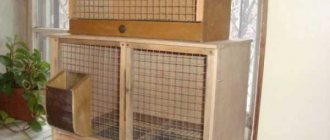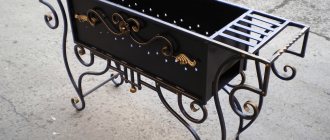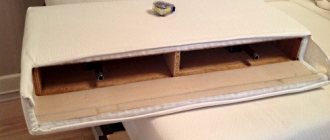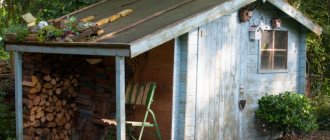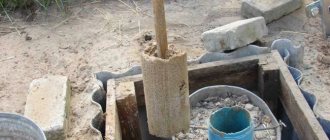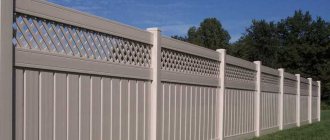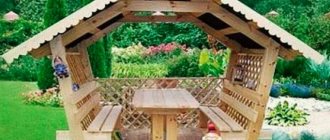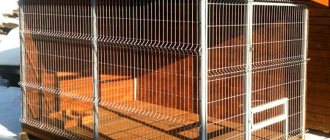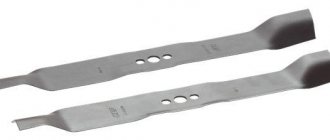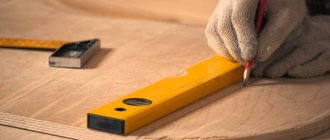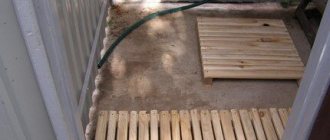The branches left behind after tree trimming are quite an inconvenient waste. Piled up in a heap, they take up a lot of space, and you can’t put the branches into the oven right away; it takes a long time to chop them with an ax. Making a fire and just burning it in the garden is a shame. A suitable option for a thrifty owner is to make a branch chopper with your own hands to process them into wood chips. And there will be a use for it - even burn it in a cauldron, or use it for compost. We are interested in the designs of homemade crushers, since the prices of factory units are not comparable with the volumes of wood processing in an ordinary private sector.
Shredder design for branches and grass
The purpose of the unit is to quickly and safely grind plant debris. The main function is performed by the cutting block. The knives are driven by the engine directly or via a belt drive. The units are installed on a stable frame. The moving elements are covered with a casing. Two compartments are made for feeding branches and unloading chips.
Metal frame
A homemade shredder with a powerful electric or gasoline engine needs a stable, durable frame with space to install the engine and a rectangular support for the cutting unit.
To make the shredder frame use:
- profile pipe 25;
- corner at 30;
- channel.
Fasteners:
- ears for the engine,
- nuts,
- hairpins.
Engine
Full autonomy, work anywhere in the garden, independence from the outlet - the advantages of a gasoline engine. A homemade shredder for processing branches, tomato tops, and grass is equipped with a motor from a motor-cultivator or walk-behind tractor with a capacity of 6 liters. With. It is moved from one unit to another.
You need a gearbox that provides 90° rotation if the gasoline engine has a horizontal shaft and the chopper has a vertical shaft.
Electricity costs are lower than gasoline, so if there is a network on the site, an electric motor is installed on the unit. To chop branches 2-3 cm thick, a 3-phase electric motor of 2200-3500 W is sufficient. When making a low-power grass cutter, they take engines from household devices. They are removed from washing machines and vacuum cleaners.
Knives
The thickness of the branches processed by the shredder depends on the design of the cutting unit. In home-made designs, several options are implemented:
- to grind branches with a diameter of 7-8 cm, several cutters are installed on the shaft;
- hammer-type cutting block for grinding thin rods;
- the universal cutting mechanism is made of 15-30 circular saws mounted on a shaft;
- knives from factory garden equipment - brush cutters, lawn mowers;
- chop grass - trimmer line;
- stump crusher from a plane;
- two shafts with 3-4 steel knives for cutting branches of bushes and trees.
Homemade knives are made from springs.
Protective cover
To prevent chips from flying around, you need a protective cover. It is made from sheet steel with a thickness of at least 1.5 mm. Tin is not suitable for this purpose. During active use of the shredder, it quickly becomes deformed from strong impacts of wood chips.
Container for receiving sawdust
Old shopping bags, boxes, buckets, and bins are used to collect small garbage. For powerful units, the bunker is welded from steel sheets and riveted from galvanized steel.
Electrical wires and start/stop button
To turn on and off a homemade unit, use a push-button station designed for the appropriate current. Its purpose:
- turning off and turning on electrical equipment;
- changing the direction of rotation (reverse).
To connect the engine to a three-phase network, you need a five-core flexible copper cable in double insulation; for a single-phase household network, a three-core cable is sufficient.
Installation of a garden shredder
Assemble the device as follows:
Before you start building a wood chipper, you need to make a drawing of the device.
Cut knives from car springs. This task is quite complicated, so it is better to turn to a professional turner. The size and shape of the knives are selected depending on the length of the electric planer drum that you will use. For example, for a shaft 17 cm long, four knives are sufficient (2 elements in each of two opposite clamps).
Weld a frame from the corner. The dimensions of the frame depend on the dimensions of the engine.
Install the motor on the edge of the bed, and the drum with knives approximately in the middle. Secure the engine firmly with nuts and bolts. The drum should be mounted on the frame using bearings through bushings. Install the frame itself with the shaft on the frame so that it is possible to move the drum slightly longitudinally to adjust the belt tension.
The drum and motor shaft must be positioned strictly parallel. The distance between them is determined by the length of the belt.
Place pulleys on the motor shaft and drum pin (the smaller one on the drum, the larger one on the motor). They must be located strictly on the same line, otherwise the belt will fly off.
Between the drum and the motor it is necessary to install a chipper (cut from a corner), which will direct the chips downwards. Even at the stage of drawing up the drawing, mark the holes for the protective casing and fastenings for the container for wood chips.
The casing itself, in addition to protecting against injury, serves as a neck where branches are fed for chopping.
Install the starter, chip tank and protective cover on the machine, after which you can start working.
You can install a circular saw on the free end of the drum shaft, then you will have a universal woodworking machine.
You can learn more about how to make a branch chopper at home from the video.
Types of shredders
Devices for processing branches have many names: wood chipper, wood chipper, branch chopper, shredder, branch crusher, branch cutter, chopper, etc. Regardless of the name, their design is almost the same. The branch chopper device includes:
- Two bunkers. Wood for chopping is fed into one, and finished chips are unloaded from the other.
- Protective cover.
- Steel frame. All structural elements are attached to it.
- Drive unit. Gasoline, diesel and electric engines are used, from which the shaft comes.
- Cutting elements.
- Main gear. It can be on a rigid coupling or on a belt.
Homemade branch crushers are divided only by the design of the cutting mechanism. They are designed almost identically. Other items may vary in size. You can take ready-made drawings of a branch cutter (it will be easier to assemble the device with your own hands using ready-made designs).
The most common solutions:
- Several dozen conventional circular saws, which are made of a hard metal alloy, are attached to the shaft.
- The shaft is provided with several grooves with chopping knives (single core crusher). Crushing elements are made of high carbon steel. The wood is fed perpendicular to the knives.
- Branches must be fed into the disc crusher at an angle of 45 degrees. This is usually built into the bunker design.
- Sometimes a shredder is made with two synchronously rotating shafts (double-shaft crusher). The knives are mounted on them. When rotating, the blades converge with each other at one point. This design ensures self-tightening of the wood. Feeding occurs perpendicular to the knives.
An increase in torque is ensured by installing a flywheel. It is placed on one of the ends of the shaft. The only exception is the disc crusher, since instead of a flywheel it has a metal circle.
Drafting
For example, we determined that a twin-shaft shredder with a low rotor speed is suitable for production tasks.
His project necessarily includes:
- engine selection by power;
- calculation of gear ratio and selection of factory model;
- determination of the diameter and length of the rotors (based on the size of the loading window);
- calculation of shafts for strength;
- selection of bearing supports.
To do this, you will need the textbook “Machine Parts” for universities. You will also have to look at GOSTs on threaded connections, reference books on gearboxes, bearings, couplings and other assembly units.
This must be taken into account when assigning groove dimensions.
After the calculations, it is necessary to layout the components on graph paper or in an editor such as AutoCAD, determine the dimensions of the body parts and the frame.
Types of shredders by engine power
As already mentioned, for small volumes of raw materials a medium-power engine is sufficient. This means you can use an electric motor. Although such a shredder for the garden requires a connection to the power supply, it is structurally simpler than a gasoline shredder and is easier to make with your own hands.
Depending on the power of the power plant, the chopper is capable of processing branches of different thicknesses. According to this indicator, shredders can be divided into three categories:
- engine power up to 1.6 kW. A unit with such a power plant will be enough to chop branches whose diameter does not exceed 2 cm. Such devices are not suitable for high-intensity work;
- power 3-4 kW. Capable of working with material with a diameter of up to 4-4.5 cm;
- over 4 kW. Using such a device, you can grind logs 7-14 cm thick.
Keep in mind that powerful electric motors must be connected to a three-phase network. When using a single-phase home network (220 V), the output power drops by 2 times. If there is no possibility or desire to equip the site with three-phase power, it makes sense to consider assembling a device based on an internal combustion engine.
Depending on the planned volume of work, to make a garden shredder with your own hands, you can use motors from various household electrical appliances:
- from an angle grinder;
- trimmer;
- washing machine (together with the tank);
- powerful asynchronous three-phase motor (type AIR 100 L4 4 kW at 1500 rpm), etc.
Conclusion
When assembling a garden shredder with your own hands, you need to start from what branches you plan to cut with it. Disc options are suitable for small and medium-sized branches, but for large volumes, a two-shaft design is better. If you have any questions, write in the comments, I will try to help.
A homemade shredder is a good help in the household.
Ecology of consumption. Estate: After pruning trees in the spring, most gardeners are faced with the problem of disposing of old branches. This is where a garden shredder can come to your aid - a device that turns the raw material into chips or flour.
After pruning trees in the spring, most gardeners are faced with the problem of disposing of old branches. If you are an economical owner, accustomed to putting all waste into use, then most likely you send all the branches to the compost heap. All this stuff rots there and in 3-4 years you are guaranteed to receive excellent organic fertilizer - compost. All this, of course, is wonderful, but it takes too long. If you first chop up the branches and leaves on them, your compost will mature within a season, or even in a couple of months. And here a garden shredder can come to your aid - a device that turns the source material into chips or flour. The devices available for sale are not cheap, so we suggest you read the instructions on how to make a garden shredder with your own hands.
Briefly about the need to process grass and branches
The garden owner does not need to explain why he needs a shredder. After each sanitary, rejuvenating pruning of fruit and berry bushes and trees, mountains of branches accumulate. A shredder is needed to grind them.
Farmers and gardeners also need a shredder. It is used to process different types of plant materials:
- potato tops, tomatoes;
- stalks of corn, sunflower;
- grass, leaves.
The chopped green mass is used as livestock feed and poured into compost heaps. Large fractions of branches are used instead of firewood, medium and small fractions are used as mulch and raw material for composting.
Why is it better to make a chopper yourself?
A rational solution for disposing of branches is to use a garden shredder. This is a special tool that is produced by modern manufacturers. The equipment operates from various types of drive devices, which can be used:
- electric motors;
- internal combustion engines;
- tractor power take-off shafts.
A significant disadvantage of factory equipment is its high cost, which is associated with the use of high-quality materials for production. Not every summer resident can afford a purchase of this kind, especially since its payback will take at least 5 years. The question of how to make a simple branch chopper yourself is becoming increasingly relevant.
The method of making garden tools yourself is in demand for a number of the following reasons:
- The manufacturing procedure is not difficult if you have experience with tools such as an angle grinder, a drill and a welding machine.
- Equipment is created from improvised means. For this you will need old electric motors, cutters, crushers, jointers, etc.
- Manufacturing of tools with the required technical parameters and performance. It can be used to shred branches, grass, leaves and other garden debris.
- Price is the main reason why summer residents prefer to make a branch shredder themselves rather than buy factory equipment, the cost of which is quite high (if we talk about high-quality installations).
Naturally, one cannot fail to mention the disadvantages of making a chopper yourself. The main disadvantage is safety, since the slightest miscalculation can result in serious injury or even cost a person’s life. That is why you should get down to business only with full confidence that you can make a reliable wood chipper. A description of the different equipment options presented in the material, which functions no worse than factory products, will help with this.
How to start making a wood chipper
Starting work on creating a wood chipper with your own hands involves choosing the design of the equipment. After all, installations are divided into three main classes:
- Disc shredder.
- Drum - for obtaining larger fractions of material.
- Double-drum crusher - allows you to produce large-sized wood material, which can be used as a heating raw material.
The next step is to select a suitable drive device. Electric motors or internal combustion engines are used as such. The use of a gasoline engine allows you to get not only a highly productive, but also a mobile unit. However, finding an internal combustion engine of sufficient power is quite problematic, which cannot be said about electric units. If you can’t find one on the farm, you can always buy used ones at an affordable price.
The thickness of the branches that can be chopped depends on the electric motor used. The greater its power, the correspondingly higher the capabilities and service life. When choosing an electric motor for making a wood chipper, you need to consider the following:
- If the power of the unit is up to 1.5 kW, then it is capable of handling sticks with a diameter of up to 20 mm.
- If a more powerful unit up to 3-4 kW is used, then it is capable of crushing branches up to 40 mm thick.
- To crush workpieces from 70 to 150 mm, electric motors with a power of 4 kW are used.
It is worth considering that the more powerful the unit, the greater the electricity consumption. If you are wondering how to make a branch chopper with your own hands for your home and garden, then choosing an engine with a power of more than 2 kW does not make sense. Logs with a diameter of 40 mm or more can be cut with a chainsaw and used as heating material.
This is interesting! When choosing an electric motor for a shredder, consider how it is connected to the electrical network. When connected to a single-phase network, the power is reduced by 1.5 times.
When the design of the shredder and the electric drive of the appropriate power have been selected, you can begin to prepare the necessary parts. Usually, to obtain these, you cannot do without the help of a turner, but it all depends on the selected device configuration. The final stage in the production of a garden shredder is the preparation of the frame on which the drive and shredding mechanism will be placed.
Main units of the unit
There are many types of mechanisms and the prices for the models are different, but both factory and home-made ones consist of the same components, the only difference is in size and layout:
- The basis is a metal supporting frame, often made either from a corner or from a profile pipe;
- The heart of any unit is the power plant. Here it is an electric or gasoline engine, diesel is used less often;
- The most important unit is the cutting part;
- Depending on the design, there may be a transmission mechanism. More often it is belt driven, but on powerful units there are chain and gear drives;
- Neck for feeding material;
- Bunker for collecting wood chips;
- Protective devices and covers.
The general design of all shredders is similar.
It is unrealistic to cut through all the components, so I will talk about the main ones, that is, about the types of power plants and the cutting unit.
Types of power plants
The main and only advantage of shredders with internal combustion engines is their autonomy. The price of such devices is an order of magnitude higher, plus these engines are quite bulky and heavy. When installing it yourself, the drive for a walk-behind tractor is most often used.
The power of the internal combustion engine for the shredder must be at least 6 horsepower.
The sheder with an internal combustion engine is completely autonomous.
Materials
Used to assemble a garden unit:
- sheet steel from 0.8 to 2.5 mm for housing and receiving hopper
- steel angles, channels
- fastening elements
- engines from old machines
- belts, pulleys
- knives, circular discs
- Welding machine, grinder, electric drill, hacksaw, pliers, screwdrivers
- Hammer, wrenches
- Ruler or tape measure, marker
Step-by-step instructions and nuances of work
1.Select your own version of the mechanism
2. A diagram is drawn to fully represent the dimensions of the unit and its parts
3. The engine is selected: electric or diesel
4. All components are manufactured
5. The frame is assembled
6. The cutting part is installed in the main body, the choice depends on the thickness of the branches and the volume of work
7.Protects the motor and belt drive
8. The engine is connected, the operation of all elements is checked
If you have experience using a welding machine, grinder and drill, then the work itself will not create any special difficulties
A do-it-yourself branch crusher is easily created according to drawings from the remains of agricultural equipment, unclaimed sheets of iron and parts from old machines and machines.
The cost of the created device will be much cheaper than a new one
You can assemble and disassemble the mechanism, remake it if you don’t like it, improve it, add a strong engine, etc.
Corn husker from grass cutter
Alex Nk
I decided to use a grass cutter to make a mechanism for shelling corn. The result is a two-in-one unit. To make a homemade product you need:
- Cut a disk out of metal.
- Drill holes in it for M6 bolts.
The tank has been redone. A “reflector” was attached to it to throw the corn “cobs” into the bucket.
Grass cutter-corn sheller assembled.
Places for storing fasteners.
To prevent the grass from wrapping around the motor shaft, the user installed a protection ring.
I found experimentally that the optimal option for chopping grass is two knives. Four knives turn the grass into mush. I also threshed apples for the poultry. One bucket of apples is crushed in 4-5 minutes. The result is a grass cutter-vegetable cutter-fruit cutter.
Most home craftsmen can make a grass cutter. Use an oil flask, barrel, etc. as a tank. To make a homemade product, you will need a set of tools:
- Bulgarian;
- drill;
- welding inverter;
- set of locksmith tools.
The main consumable part is the engine. Users used used drives. Is it profitable to make grass cutters yourself? Compare prices for factory models and calculate how much it will cost you to buy parts for homemade products. Don't forget to add time costs.
Want to know more? to the authors of grass cutters in the topic Homemade Grass Cutter “Monster 2015”.
- Photo instructions for making a profile bender yourself for 2000 rubles from spare parts from old cars and bicycles, bearings, threaded rods and channels.
- 5 options for a sawhorse for sawing logs into firewood - cheap homemade devices for sawing logs into logs and splitting firewood: drawings, design, experience of use.
- A universal homemade stand for an angle grinder with a rotating mechanism, an eccentric clamp and metal cutting in two planes.
What do you use to make manual labor easier?
More information on this and other topics can be found at FORUMHOUSE. Become a member of the most famous portal about country life and construction!
Source: zen.yandex.ru
Schemes and drawings
Before searching for components and assembling them, it is necessary to draw up a diagram or drawing of the chopper. This is necessary to avoid errors when assembling and operating the shredder, otherwise improper operation will lead to injury to the operator. When drawing up a diagram or drawing, all stages of grinding are taken into account:
- Loading the device.
- Grinding branches.
- Accumulation of crushed particles, as well as their removal.
It is not necessary to draw up a drawing according to ESKD standards; it is enough to correctly note the location of the elements and their dimensions. According to the diagram, a list of necessary components is compiled, as well as the order of assembly of the chopper.
In addition to drawing up your own drawing, you can use a ready-made one from the Internet. The advantage will be that all the nuances have already been thought out and reflected in the diagram. The disadvantage is that the drawing is prepared for other parameters: performance, type of branches. In addition, the finished drawings may contain elements that are not at hand - this will increase the cost of the project.
Homemade electric shredder
You can make your own chopper if you have the necessary elements. The most practical is considered to be a branch crusher consisting of two shafts. For manufacturing, a drawing is created according to which the assembly is carried out.
Initially, the necessary material and tools are selected:
- electric motor with rated power up to 4 kW
- a pair of steel plates up to 10 mm thick
- two gears made of high-strength steel
- a couple of pulleys
- shafts, hardened and machined
- bearings for reliable shaft mounting
- direct cutting steel blades
- metal case
- steel pipe of the required diameter
- set of wrenches
- welding machine
- powerful drill or hammer drill
From a square blank we grind shafts on both sides. In the center we drill holes for 4 knives, threads are cut into them. The rounded edges are inserted into bearings. The drum is made from 4 studs and two steel plates in which holes are cut for the bearings.
Bearings and pulleys are firmly secured to the shaft, and gears are installed on the opposite side. We install the housing with the cutting mechanism and the engine on the pre-prepared frame. The transmission of torque from the drive will be carried out using belts through pulleys on the motor shafts and knives.
The receiver body is made of sheet metal, cut in the shape of 4 trapezoids. Using a welding machine, they are fastened together in the form of a truncated pyramid. The box is connected to the cutting mechanism body using a bolted connection.
Attention! Must be tested without load before use.
Garden shredder from washing machine
To assemble a branch chopper with your own hands, you need to carry out the following manipulations:
- The activator is removed from an old type washing machine.
- A pre-made knife is installed directly on the motor shaft.
- The size of the working tool is made slightly smaller than the diameter of the drum.
- A hole is cut in the lower part of the body from which the wood chips will spill out.
- The housing is attached to the hole.
This design allows you to process small debris, grass, or tops of small plants, with a relatively low power.
Homemade grinder grinder
Making a branch chopper with your own hands from a grinder is divided into several stages:
- We take a 20 liter bottle, cut off the bottom part, and enlarge the hole in the top. This will be the receiver.
- We pass the axis of the device from the side.
- We install the cutting element on top of the shaft and securely fasten the entire structure.
Important! When rotating the knives, the blade should not touch the walls of the receiver body. To start chopping, the branches are loaded from above and the grinder is turned on at minimum speed.
Trimmer crusher
For a branch chopper made with your own hands from a garden trimmer, you need to prepare the following necessary elements:
- container made of plastic or metal with a volume of up to 50 l
- several metal pipes with a diameter of up to 20 mm
- steel network with an area of about 1 sq.m. with a small mesh
- scrap of wooden board or plywood
- you need to purchase metal clamps for fastenings
- wooden blocks and screws for fastening them
- directly the trimmer itself of any design
As an auxiliary tool, it is recommended to prepare:
- screwdriver
- anvil
- drill
- jigsaw
- plumber's hammer
In order to make a chopper, you must follow the step-by-step instructions:
- Initially, prepare the container of the veterinary chopper. To do this, holes in the form of trapezoids are drilled and cut out at the bottom. The edges are processed.
- The mesh is secured to the bottom using bars. This creates a membrane.
- The container is placed at a low height using a pipe structure.
- The trimmer motor is mounted on the board.
- The rod of the device is shortened slightly and also installed on a base with a drive.
- A cutting tool is placed at the end of the rod.
- Before carrying out actual work, tests must be carried out. You can use different attachments to chop branches of different thicknesses.
From a walk-behind tractor
It is impossible to make a full-fledged main working unit from a walk-behind tractor; it only acts as an engine. To do this, you will need additional elements: drive, shaft. Tools such as a channel bar and a plane (electric) are suitable. In addition, you will need bearings and a pulley to operate the shaft. A walk-behind chopper is one of the most difficult devices to assemble yourself. It will be necessary not only to select a rotating device, but also to connect it to the walk-behind tractor, and also to design housing protection elements.
From circular saws
The most common grinding mechanism is disc cutting. Circular saws are used for assembly: 20-30 pieces per 1 chopper. They are located on the shaft one after another, due to which the entire width of the input “pocket” is filled. The spacing of the disks one behind the other must correspond to the required size of the crushed particles. Adjacent disks are positioned diagonally relative to each other so that branches do not slip past and are cut at an angle.
Twin shaft design
The most complex design is two-shaft. It uses only disc cutting elements, which are located in the housing on two shafts. Due to this, the chopper is able to grind large branches: first it pulls them in, and under the force of the discs on both sides, large pieces are crushed. The design is similar to a disk chopper, which is complemented by a second shaft.
The arrangement of the disks is chosen in a checkerboard pattern and diagonally to completely eliminate clogging and friction of the disks against each other. Shredders work on a similar principle: they place blades in several shafts that crush and cut the incoming raw materials.
From a drill
Many home craftsmen prefer a drill to washing machines and electric planers when making a garden shredder. The operating principle of such a device will be in many ways similar to a vegetable cutter. To make a structure of this type, the following steps will be required.
- Take an old stool. Drill a hole in it, its diameter should be 12 mm. On the other side of the stool, attach the housing part with the bearing.
- Place a bucket of suitable diameter on the stool and securely secure it with self-tapping screws.
- Insert the bearing into the hole. A shaft with steel knives installed will be placed on it. Closer to the end half of the shaft at the bottom of the stool, attach a dual-mode drill using a keyless chuck.
- Place soft materials into a fixed bucket and start the electric drill. After careful crushing to the required fraction, the mulch will need to be removed from the container. Please note that a unit with such a device will only be designed for a small amount of waste and debris.
Special attention should be paid to all stages of manufacturing and sharpening the knife. The sharpening must be one-sided. The ground base should be located at the bottom.
To chop freshly cut grass, it is advisable to use a knife whose shape follows a diamond shape (the blades should be slightly rounded). Thanks to this feature, the grass can easily slide along the cutting edge of the knife without wrapping around it.
From a plane
Many home craftsmen make reliable and practical shredders from certain planer parts. There are a lot of options for execution using this tool. Let's consider one of them.
When combined with elements of an electric planer, you can use a walk-behind tractor. The single combination produces a fairly powerful and productive machine. To assemble it you will need:
- electric planer knives;
- walk-behind tractor;
Assembly
First you need to select a disk for the crusher. The mounting hole in the disk must fit onto the shaft section. Three slits must be carefully and carefully made in the disk.
Length – two thirds of the radius. One hundred and twenty degrees angle between them. Two centimeter slits. Also make two holes on each knife. The holes on the knives are eleven millimeters, and on the disc there are nine. The thread in the disk is M10x1. Place the knives on the disk. The disk is placed on the shaft. The shaft with cutting edges must be on bearings. We need to check the balancing. If it is incorrect, then you will have to redo the last steps.
Insert your fingers into the disc from the outside. Scald the outside of them. Weld the fender plates inside the same disk. The frame assembly must match the size of both the cutting edge shaft and the blade.
Install, attach the sieve using holes and nuts. Place the pulley on the shaft, securing it with a bolt. Attach the bottom of the casing to the frame. Attach the top of the casing with loops to the bottom.
Attach the shaft installed in the desired place, attach the bearings to the frame. To reduce vibration in a crusher with your own hands, you need bushing washers.
Close the top of the casing and wind it around a rope-pulley of one and a half to two meters and untwist the shaft, making sure that there is no vibration. If vibration is present, something is wrong. We'll have to reconsider some details and do it again. You need to connect the starter with capacitors and cable and try to start it.
Operating homemade equipment
From all of the above, we can come to the conclusion that making a garden shredder with your own hands is easy and simple. Almost any user can handle this. However, it is important not only to know how to assemble such equipment, but also how to operate it correctly. Let's consider the intricacies of using a homemade device.
- You should only start chopping branches if you are wearing safety glasses or a mask. You will need a hat and a tall pair of shoes. It is advisable to send branches into the machine with bare hands or with gloves, but very narrow and tightly fitting on the hands.
- Do not put your hands below the opening of the waste bin. If necessary, you can push through the debris with a further batch of rods. It is permissible to use a special stick for this, which has branches at the end.
- The dimensions of the branch that you send for processing should not be more than half the center distance between the shafts. When selecting wood particles that you plan to dispose of, it is very important to take into account the knives used in the technique.
- Experts recommend installing a separate differential automatic machine for such equipment. This part will protect the device from possible electrical damage if unforeseen circumstances occur.
- Both during assembly and during operation of a homemade mechanism, it is very important to adhere to safety rules. Take care not only to protect your hands, eyes and feet, but also to ensure that all parts of the shredder are securely fastened.
- When working with a homemade shredder, you need to ensure that no inclusions such as stones or glass, metal or plastic get into its receiving hopper. These elements should also not be present in the container during storage. They can seriously damage the structure of the device.
- Twin-shaft units are most effective at shredding raw branches. If you need to process elements of dense rhizomes, then they will need to be thoroughly cleaned of dirt.
- If the snare drum is jammed due to wooden inclusions stuck in it, then the device will need to be immediately disconnected from the network. It is permissible to remove stuck waste in the future only when the device is de-energized. Otherwise you will put yourself in serious danger.
- During operation of the shredder (either branded or homemade), it is very important to ensure that the power cable of the device is not in the area where crushed waste is emitted.
- If you want your homemade shredder to last as long as possible, then it will need to be thoroughly cleaned after each waste crushing job performed on the site. After this, the device should not be thrown outdoors. Select a shed for it or equip a shed.
- Make sure that the knives of the device are always well sharpened. Thanks to such care, using the device will be much easier and more pleasant, and its main components will not be subject to a large load.
Only if all the listed operating features are observed, can we talk about the durability and wear resistance of the shredder that you made with your own hands. Of course, the quality of all the components that you use during manufacturing also plays an important role. Treat this equipment with care and attention. Do not forget to constantly clean it so that crushed waste does not accumulate (in advanced cases, it can be quite difficult to remove it). In addition, you should remember about your own protection while working with this equipment.
Under no circumstances should you begin cleaning or repairing it while it is still plugged in.
Safety precautions when working with homemade garden crushers
No matter how easy it may seem to use garden shredders, working with them can lead to injury:
- Always make sure that there are no small children near it when using a homemade shredder.
- Never load metal, glass objects, or construction waste into the unit.
- Do not put your hands inside during operation.
- If something gets inside or the size of the branches exceeds the power of the device, you need to turn off the engine and remove the unnecessary using some tongs.
- Always wear gloves, a protective mask and safety glasses.
- If the garden shredder is powered, it should be located as far as possible from water sources to avoid short circuits.
- Do not store homemade shredders in places unprotected from moisture or at low or high temperatures.
- Before using the shredder, always check its serviceability, reliability of fastening of parts, and integrity of the wires.
- After using the shredder, clean the body and blades of any remaining garden debris. Damaged knives should be replaced immediately with new ones.
Device
There are a lot of options for making mechanisms that free a country or yard space from a pile of wood waste:
Branch crusher. Steel base: two powerful bearings are welded to the angle. Between them there is a shaft with knives made of springs. A tractor flywheel connected to the shaft by means of a spline and a pressure nut. Feeding hopper with rounded edges, motor, pulley with belt drive.
Do-it-yourself grass and twig chopper. Iron frame, three-phase motor at the bottom. The flywheel is from an old agricultural machinery, the shaft is from a planer with circular disks. Pulley, belts, waste bin. Mobile design on wheels
Crusher: the cylinder-shaped hopper is made of KAMAZ receiver. Inside the main structure, knives are mounted on a vertical shaft according to the helicopter principle. Under which there are iron brooms with curved edges for air injection.
From the inside, a piece of steel is welded to the body along the intake hole to reduce the entrance by half. Grass and hay do not fly away into the garden, they go right under the knives.
